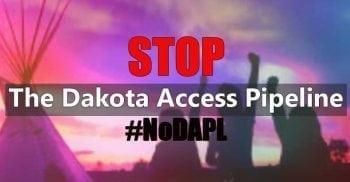This Moment at Standing Rock Was Decades in the Making
=By= Jenni Monet

Chairman Archambault of the Standing Rock Sioux (left) and Chief Arvol Looking Horse. (Photo by Jenni Monet)

Energy Transfer guard with dog. Tomas Alejo
Attack dogs and waves of arrests by police in riot gear could look like isolated incidents of overreaction to the activism stemming from the Standing Rock reservation. But for the Lakota Sioux who live in these marginalized hillsides, the escalated militarization behind their battle against the Dakota Access pipeline is a situation decades in the making.
Many people of Standing Rock are not surprised by the extreme response of law enforcement against activists.
North Dakota is not the whitest state in America, but it’s arguably the most segregated. More than 60 percent of its largest minority population, Native Americans, lives on or near reservations. Native men are incarcerated or unemployed at some of the highest rates in the country. Poverty levels for families of the Standing Rock tribe are five times that of residents living in the capital city, Bismarck. In Cannon Ball, the heart of the tribal community, there are rows of weathered government homes, but no grocery store. Tucked behind a lonely highway, this is where mostly white farmers and ranchers shuttle to and from homesteads once belonging to the Sioux.
Add to that a contempt that many Native Americans say they feel from North Dakotans and particularly from police, and many people of Standing Rock are not surprised by the extreme response of law enforcement against activists.
[metaslider id=133311]
“We’ve run on empty for a number of generations,” said Phyllis Young, a former tribal councilwoman for the Standing Rock Sioux, the community that’s vowed to stop the pipeline in its path. “But now we’re taking a stand. We are reaching a pinnacle, a peak.”
The initial occupation began in April, but since early August people from across Indian Country, and now the world, have turned up every day by the hundreds to protest ongoing construction—even if it means confronting angry workers, lines of riot police, attack dogs, and jail time.
North Dakota, a state of nearly 740,000 people, is similar to other conservative states with sizable Native American populations, places like Arizona and Oklahoma, where natural resource extractions have terribly harmed indigenous land—like the uranium mining fallout across the Navajo Nation or the lead contamination on lands leased by the Quapaws. Yet where these environmental ordeals did not so much draw the kind of activism now swelling at Standing Rock today, they have similarly intensified attention to the greater systemic problems that exist whenever ancestral tribal lands are targeted for energy development.
For North Dakotans unaware of this context, the battle against the Dakota Access pipeline has caught them off guard.
“The outsiders coming in, we feel, are bringing this unrest,” said Ron Ness, a multigenerational North Dakotan. “Certainly it’s not the norm of the tribal nations to do business here and who we all know and who we are neighbors with.”
Ness, who is president of the North Dakota Petroleum Council, represents the state’s overwhelming conservative view of the protests—a combination of annoyance and anxiety—that illustrates the historic and cultural divisions of the Northern Plains.
One thing all parties seem agree on, directly or indirectly, is that this oil pipeline is not wanted around water supplies. But whose water supply?
An early proposal of the Dakota Access pipeline once examined a route that would have extended the multibillion-dollar project 10 miles north of Bismarck. But the company, along with the U.S. Army Corps of Engineers, rejected it, opting for a plan that would snake a portion 92 feet below the Missouri River, directly under Standing Rock’s main water source.
The Corps had evaluated the Bismarck route and determined it was not a viable option. One reason: The route posed a potential threat to the city’s water supply. Municipal water wells were at risk, according to the agency’s environmental assessment. Meanwhile, the Corps stated that the initial route would have been difficult to stay 500 or more feet away from homes, as state regulations required. That’s when the agency recommended the path of the pipeline traverse the Missouri River underneath land belonging to the Corps, an easement less than half a mile away from the Standing Rock Sioux reservation.
Please join TGP in supporting the Standing Stone Tribe, and the Gathering of Tribes and other Protectors in their Actions legal and direct against the Dakota Access Pipeline.
Donate to: – Sacred Stone Spirit Camp – – Legal Defense Fund + Send supplies via Amazon Wish List And Support the Red Warrior Camp – Donate to the Camp – Send Supplies via their Amazon Wish list MORE INFO –> SacredStoneCamp.org
Meanwhile, defending the pipeline in North Dakota lately has evolved into routine theater.
The Morton County Sheriff’s Department has so far arrested as many as 69 people for what it described as illegal protest activities. On Thursday three men attached themselves to construction equipment. Many of those arrested have been charged with criminal trespassing. The majority are people who reside in other states. At least two were booked with identification from communities in Canada.
Morton County State’s Attorney’s office filed charges against four activists involved in the tense clashes of September 3, where private security guards hired by Dakota Access and its partner, Energy Transfer Partners, used attack dogs and pepper spray against protestors. The demonstration, which was video-recorded by Amy Goodman of Democracy Now!, effectively stopped pipeline construction for the day. The affidavit, including charges filed against Goodman, came in direct response to Gov. Jack Dalrymple’s call to seek reimbursement from anyone who costs the government money from their civil disobedience. That threat was made the same day the Republican governor activated the National Guard.
 This week, Kolette Ostlund, a deputy court clerk of the North Central Judicial District Office in Minot, North Dakota, received a formal warning for her Facebook comment made over the Labor Day weekend. The September 5 rant about the pipeline battle began: “Solution: let them keep their sacred land. Go around their water and burial grounds. It obviously means a lot to them and they should have it … Then … Stop the monthly checks and ALL the government payouts! Stop all the subsidies and hand-outs. Done!”
This week, Kolette Ostlund, a deputy court clerk of the North Central Judicial District Office in Minot, North Dakota, received a formal warning for her Facebook comment made over the Labor Day weekend. The September 5 rant about the pipeline battle began: “Solution: let them keep their sacred land. Go around their water and burial grounds. It obviously means a lot to them and they should have it … Then … Stop the monthly checks and ALL the government payouts! Stop all the subsidies and hand-outs. Done!”
She added, “The government has paid out enough over the last few hundred years. Enough is enough!”
At Sacred Stone Camp, where as many as 2,000 people have journeyed to pitch teepees or tents to stand in solidarity with the Standing Rock Sioux, Ashley Thunder Hawk stood in the wet grass and soft mud wearing a single white flip-flop. “The other one broke,” she laughed, wondering out loud how she would make her way around the camp.
“There is racism,” said Thunder Hawk, a lifelong resident of Cannon Ball. “We get treated shitty on our own piece of land, but at the same time we go on the other side and it’s worse. We get treated really shitty.”
In recent months, Thunder Hawk said, she’d given up on plans to move off the reservation and into the nearby community of Mandan or Bismarck. A felony record made getting a job and renting an apartment seem next to impossible. For now, her focus was on exercising extreme willpower, to ward off drugs, to resist alcohol, and to ignore a wave of negativity that seemingly permeates the reservation. The 24-year-old mother could count the days of her sobriety: six months and 13 days. Ron Yellow Jr., the father of her only child, was on the same healthy path.
In Thunder Hawk’s world, practicing sheer determination is even difficult to do. “If you want to go somewhere, you gotta drive maybe 50-60 miles north to have fun or something, you know?” She paused and shifted her weight onto her naked foot.
Yellow Jr., 37, added, “It’s why a lot of people say that we’re stuck here.”
The social problems, many tribal residents say, began when treaties were broken and ancestral lands were lost to colonizers.
The existing land base of the Standing Rock Sioux was determined by the Treaty of Fort Laramie in 1868. When the U.S. government claimed victory 11 years later, following the Great Sioux War, the terms of that treaty were amended. Threatened by starvation, the tribe, under duress, ceded a great deal of Laramie land to the federal government. In partial recognition of this painful history, modern federal Indian law today accords certain rights to tribes, including entitlement programs linked to health care, housing, education, and even gaming.
But even with these concessions, reservation life across Indian Country is often bleak and exacerbated by a disconnection from political power or voice.
Consider North Dakota’s strict voter-ID law.
Chase Iron Eyes, the first Lakota Sioux to run for the state’s only congressional seat, said he has witnessed many Native American voters being denied access to the polls. North Dakota doesn’t have a voter registration system. Instead, the state has required residents to provide valid identification. Polling precincts have accepted driver’s licenses and state-issued identity cards, as well as identification from North Dakota’s federally recognized Indian tribes.
But there’s one catch: All IDs must have a current address.
“In Indian Country we all know damn well that we don’t have physical addresses,” said Iron Eyes. The 38-year-old attorney and member of the Standing Rock Sioux tribe is running for Congress, challenging incumbent Kevin Cramer, a Republican, who’s been the U.S. representative for North Dakota’s at-large congressional district since 2013.
“I never had a physical address until I came back from law school,” Iron Eyes continued. “Our whole lives we have P.O. boxes, and so this is something that in the law we have to prove discriminatory intent.”
In August, a federal judge issued a preliminary injunction that will make it easier for Native Americans to cast their ballots in the upcoming general election. But the court ruling didn’t strike down the 2013 law. With only weeks left before Election Day, North Dakota’s secretary of state vowed to review the issue during the next legislative session, in early 2017. Like so many voter-ID laws nationwide, the North Dakota statute was passed by a Republican-led legislature that claimed a need to curb statewide voter fraud.
“If Native people don’t vote, what you get are instituted roadblocks and military-style checkpoints,” Iron Eyes said, referring to the National Guardsmen staked out along Highway 1806, a direct response to the pipeline protests.
Iron Eyes faces an enormous political battle.
What happens here once the pipeline battle ends?
To begin, his opponent can outspend him by nearly a million dollars. (T-shirt sales have been a humble fundraising approach for the Iron Eyes for Congress campaign.) The Democratic National Party will not formally endorse him. With only around $40,000 in campaign coffers, he lacks the money to interest the DNC.
And so Iron Eyes must rely on a vast Native American turnout to come even close to a win. Most tribal members are too poor to donate. Voting, at least, is free.
To be sure, North Dakota is a state dominated by Republican influence.
During North Dakota’s GOP convention last April, Cramer was among the first to endorse Donald Trump. It was a show of support soon followed by the state’s governor, who now sits on Trump’s newly created agricultural advisory committee.
The state’s Democratic senator, Heidi Heitkamp, is an advocate for Native American programs in North Dakota. But she has remained mostly silent on action swirling around Dakota Access. On Thursday, though, she was compelled to respond after online threats were made by the hacker group Anonymous, targeting North Dakota lawmakers and law enforcement.
“Threats of violence cloaked in anonymity never have and never will have any place in North Dakota,” Heitkamp’s statement read.
That Anonymous has entered the fight for indigenous rights at Standing Rock, whether the occupation’s organizers like it or not, helps amplify a very simple narrative: “We decided to stand with Native Americans whose lands you raped, whose sacred lands you destroyed,” said its video mostly addressed to Gov. Darymple.
Despite the passionate and widespread support for the Standing Rock Sioux’s position, the outlook for defeating a pipeline is grim.
The very fact that the tribal community is situated in the state’s poorest county, Sioux County, prompts the question: What happens here once the pipeline battle ends?
Systemic poverty that has gripped this tribe goes beyond a lack of money. It involves often young lives burdened early by hopelessness, homelessness, alcoholism, and chronic suicide. More than half of Cannon Ball’s students drop out of school.
Addressing areas of insecurity would do Standing Rock justice. Despite its position on the prairie, it’s a virtual desert—of data, healthy foods, digital technology, political representation.
“Fear of racism, it’s alive and well in the Dakotas,” said spiritual leader Arvol Looking Horse about the sentiments among the Lakota. “And today, it’s even gotten worse because of our political leaders.”
Looking Horse was the elder who led a ceremonial blessing for President Obama during his visit to the Standing Rock Reservation in 2014. “Americans don’t even know that we exist today,” he continued.
“But finally, the world is watching,” he said
“We have no choice but to stand on prayer and peace and unity, because in our circle there’s no ending and beginning. We are all equal.”
![]() Jenni Monet is an award-winning journalist and tribal member of the Pueblo of Laguna in New Mexico. She’s also executive producer and host of the podcast Still Here, launching in September 2016.
Jenni Monet is an award-winning journalist and tribal member of the Pueblo of Laguna in New Mexico. She’s also executive producer and host of the podcast Still Here, launching in September 2016.
Note to Commenters
Due to severe hacking attacks in the recent past that brought our site down for up to 11 days with considerable loss of circulation, we exercise extreme caution in the comments we publish, as the comment box has been one of the main arteries to inject malicious code. Because of that comments may not appear immediately, but rest assured that if you are a legitimate commenter your opinion will be published within 24 hours. If your comment fails to appear, and you wish to reach us directly, send us a mail at: editor@greanvillepost.com
We apologize for this inconvenience.
 Nauseated by the
Nauseated by the
vile corporate media?
Had enough of their lies, escapism,
omissions and relentless manipulation?
Send a donation to
The Greanville Post–or
But be sure to support YOUR media.
If you don’t, who will?



